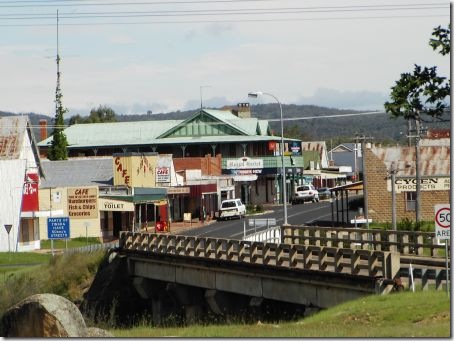Saturday, February 28, 2009
The problems of being off-line
The frustrations have been enormous. Posting has been almost impossible. To post, I have had to put the post onto a memory stick and then upload from work. Equally importantly, I have not been able to read what others have been writing.
Hopefully things will get a little easier now.
Wednesday, February 25, 2009
Train Reading - J H Curle’s The Face of the Earth
It has also been more frustrating than I expected. The writing bug is now so deeply embedded in my system that I kept seeing things that I wanted to write about and then could not.
My train reading has switched to J H Curle’s The Face of the Earth, a book I finished yesterday. Mr Curle was a very popular English travel writer during the 1930s; Face of the Earth was published in 1937.
I will write about the book in more detail later. While well written, many today would find some of Mr Curle’s views quite offensive. I want to discuss this because I deliberately chose the book to get a snapshot of the world just prior to the armageddon described in Pacific Fury, Peter Thompson’s history of the war in the Pacific.
In some ways I got more than I bargained for.
The book is laced with comments about nationality, race and ethnicity expressed with a freedom that would not be tolerated today. I almost put the book aside after the first chapter with the thought do I have to read this stuff? I kept going because I had, after all, deliberately chosen the book as a window into a past world.
As I read I found that I could put aside my reactions.
The travel descriptions across the Pacific, Asia, Latin America, the Middle East, Africa and Europe are remarkably interesting. As I read about travels through the frontier provinces of what is now Pakistan including a visit to Kabul, I could not help but contrast Mr Curle’s descriptions with current realities.
As I read I also found that Mr Curle’s views on race and ethnicity were layered, nuanced, in a way that was not immediately apparent. They also lead him to make some remarkably interesting observations.
I do not recommend this book for all. I think that for many, the offence would simply be too great. Here I quote from Peter McCarthy:
JH Curle was a mining engineer and successful travel writer. His views on eugenics made him a pariah when the Nazis rose to power. His books are a mix of humorous personal and mining history, observant travel experience and racism. Of his degree at Cambridge he wrote: “The University authorities were approached as to a mining course, but it was soon evident they knew rather less of mining than I did; it was outside their ken. It ended in a scratch course in geology, chemistry, and hydrostatics; but of their practical bearing on mining I learned nothing, and left the University in complete ignorance of the profession I hoped to enter.” Curle, a friend of Hoover, traveled the world for years as a mining journalist for The Economist and wrote “The Gold Mines of the World” to much industry acclaim.
Despite this, I do plan to discuss some of Mr Curle’s views because of the insights they provide into past thoughts and perceptions.
In the meantime, my next train reading is Valentine Williams autobiography, The World of Action (Hamish Hamilton, London, 1938). While very different, I am reading it for similar reasons as to J H Curle.
Valentine Williams is one of three generations of journalists who worked for Rueter's almost from its foundation.
Thursday, February 19, 2009
Problems of perception and unseen bias
We moved yesterday - chaos. I will be off-line from the home office until at least next Tuesday, so this is going to really slow me down.
In my train reading I have now finished Peter Thompson's Pacific Fury: how Australia and her allies defeated the Japanese scourge.
As I said in my first comment, I found it a good read, although I do think that there is an anti-British bias. He gives a fair serve to perceived incompetence and bias of all types. It's just that he has a tendency to add the word British or English before a name case, leave the equivalent descriptor out in the case of other nationalities.
Oddly, this fits with my next train reading, Malcolm Gladwell's Blink (Penguin 2006) because this deals in part with the way prejudices influence perception.
The core of Gladwell's book deals with the way humans make instantaneous judgements, quick judgements based on limited information.
These judgements can be remarkably accurate. Gladwell attempts to explain why. Importantly, he also explains why they can be disastrously wrong.
Some of his arguments link to things that I have written about not just on this blog, but also in my management writings.
I noticed what I saw as Thompson's bias, but most Australians would not because this type of bias has been widely expressed to the point that it has become perceived wisdom.
My purpose here is not to attack Thompson's position in any rigorous way. I am simply using it as an example of the way in which perceptions affect thinking.
Of course we all know this at an intellectual level. However, it is very hard for us to recognise the actual effects on our own thinking and judgements.
Often when I write on these issues, my thoughts are set in the context of a different argument.
For example, I spoke of mirroring - the way in which our behaviour and ideas come to reflect and respond to the perceptions and action of others in relation to ourselves - in the context of the Australian Aborigines' perceptions of themselves. However, this is but one example of a broader phenomenon.
Perhaps more on this later.
Tuesday, February 17, 2009
Indonesian experts arrive to help identify Victorian bush fire victims
I see from yesterday's Sydney Morning Herald that Indonesian body identification experts have arrived to assist local police with the large workload from the bushfires.
This photo by Ken Irwin shows the team arriving at Melbourne airport.
The initial contingent of six officers from the Indonesian police victim identification unit is likely to stay for at least six months, and will be followed by as many as 14 more officers.
Five of the officers worked on the crime scene after the Bali attacks of 2002 and 2003, and also on the team that identified bodies in the wake of the 2004 Boxing Day tsunami that killed more than 150,000 people in Indonesia.
While it's sad to think that the Indonesian expertise was developed out of tragedy, it's also nice from an Australian perspective to have the support. I hope that this will be another small step in building bridges between the two countries.
Still on the fires, since I wrote Saturday morning musings - issues raised by the Victorian fires, radio reports have pointed to some conflict between official relief efforts and the very quick, early, volunteer response.
This is a difficult area.
Official responses are bound by rules, as well as the practical difficulties involved in trying to cope with a disaster across such a wide area. This means that volunteer responses can be quicker in meeting immediate needs. However, this can create tension between the two.
To my mind, Australian's volunteer can do spirit is the first line of defence in dealing with many community problems. However, Australians also have a tendency when Governments step in to say well, okay, it's your problem now. They withdraw, so that official space replaces the private, volunteer, space.
For a number of reasons, Australian Governments are not especially good at dealing with local variation. Common sense gets a bit lost in the desire for uniform approaches.
I suspect that it's time that we had something of a national conversation about ways of building community spirit and of reconciling the conflicts that can arise.
Monday, February 16, 2009
Tingha - a case study in community regeneration
A short note this morning linked to another of my recurring interests. I will do a fuller post later on the New England Australia blog.
I have been interested in regional development for many years, driven in part by the seemingly inexorable decline of many areas in inland New England and, more broadly, country Australia as a whole. I have never accepted that this must be inevitable.
The small community of Tingha, an hours drive north west of Armidale, 15 minutes drive west of Inverell is a microcosm of the problem. This town has rich history. It developed with tin (it was once a major Chinese centre), but then declined as the tin declined.
At the last census, Tingha's urban population was 713, one third indigenous. The unemployment rate was over 18%, a further 30% worked part time. Thirty five per cent of the working age population gave their occupation as labourer. This has become one of the poorest communities in Australia measured by the conventional stats.
Now Tingha is trying to rebuild itself from the bottom up, using a community re-generation approach developed by Bob Neville. Those who are interested can find out more here.
Sunday, February 15, 2009
Sunday Snippets
I may not be able to post much this week - we are moving. We need a bigger house, Clare in particular has no space, but dear I'm going to miss the garden. This is my main personal escape.
I had a good response to my post Saturday morning musings - issues raised by the Victorian fires. I put a fair bit of time into the post, so that's nice.
On Management Perspectives I have continued my musings on the state of the Australian economy, while on the New England blog I am now posting my Armidale Express columns with a weeks lag. You can find the whole series here.
To finish with another photo from Cousin Jamie's collection. This one shows a Belshaw family picnic. It is quite stylised.
In many ways the world of at least middle class Australia of the 1950s was far more formal than Australia today. 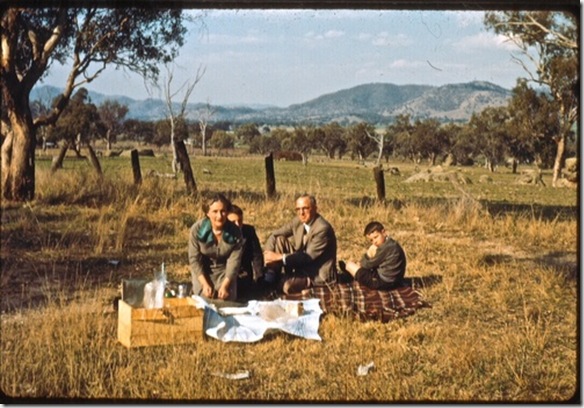
Saturday, February 14, 2009
Saturday morning musings - issues raised by the Victorian fires
With encouragement from Legal Eagle and Ramana, this post looks at some of the lessons raised by the Victorian fires. I thought that Kanani would be interested as well because of her comments on the California experience.
I had not intended to write now, but I am starting to see commentary and responses to the fires of the type I feared focused on yet more controls. To my mind, the answers are a little different.
To start with two general points.
The first is that the choice of where and how to live is a matter of individual choice. Each choice has risks. Those risks can be managed, but cannot be removed. Our modern tendency to try to remove risks imposes its own costs, something that I have written about before.
The second is that risks vary from place to place. In the case of fires, for example, there are variations in terrain, climate and vegetation that affect the form of fires. This is directly linked, I think, to the reasons why most of Australia's most damaging fires have been Victorian. The answer lies partly in the trees.
These variations in local conditions between areas, but also over time within areas, make it hard to impose effective universal prescriptions.
Working on the front line
Effective fire prevention starts at home. If you chose to live in the bush, then you need to be prepared for it.
Nobody can be absolutely safe when you get fires as big as these blazes. However, the aim remains to survive the immediate fire front, 15 to 20 minutes. Then from this point, burning is based on local fuel.
I first came across fire preparation when I was a kid. We went down to stay in Springwood in the Blue Mountains west of Sydney. This was very different terrain from that I was used to. The house backed directly onto bush now included in a National Park. It was absolutely wonderful from a kid's viewpoint.
One morning, our hostess said that it was time to start preparing for the bush fire season.
This is a very fire prone area. She gave us all rakes. Our job was to rake up all the leaves and small twigs not just from the back garden but into the first part of the adjoining bush. We also collected branches. She cleared the gutters - we were not allowed to do this because of height. All this was put into piles for either composting or burning.
The aim was to create a buffer at the back of the house.
I use this example because I was struck in the Victorian fires by images that suggested in some ways the urbanisation of the bush. I am a townie. Still, we grew up with fire. We played with it. We also took part in burning off on my uncle's place. So we knew something about the way fire worked.
To extend this point, I want to take some images from the Victorian fires.
There was the image of the youngish bloke in shorts and a blue singlet desperately carrying buckets as he fought the fire. Shorts? A singlet?
Fire burns. If you are going to be near it, you need to be properly dressed. This need not mean fire suits, but at least long paints, long sleeved shirt, a wool pullover. There is a particular problem here because much modern synthetic clothing melts. You need natural fibres. Wool in particular smoulders rather than burns.
A second image, people spraying Pepsi onto the fires. Modern urban families depend upon electricity and mains water. In this case, power went off, some of the pipes melted. Again, you need to make sure if you can that you have some access to water, that you can wet things down.
As in the case of the Kinglake builder with his generators and equipment, even if well prepared, the fire may come so fast that you cannot use it. However, I was struck by something else here - the drapes.
If you look at many of the houses in the urban bush areas, they have huge plate glass windows to provide best views of the bush. I love the views too, but they can allow heat to enter the house.
In the Kinglake builder case, they appear to have had heavy drapes to pull across the windows. This helped reduce the build up of heat inside the house during the critical fire period.
Just to summarise to this point. As the Fire Authorities keep saying, you have to prepare your property for fire in advance,and then be prepared to deal with it when it arrives. I am sure that the Victorian Royal Commission will point to failures here.
Building Insanities - beauty vs safety
Some years ago I was Chair of the Queanbeyan Beautification Committee.
The local fire department wanted to build a fire trail along part of the Queanbeyan River. This created great local heat, in part on environmental grounds, in part because it would damage views. In my role, I had to chair local protest meetings and help organise the opposition.
At one point there was a river inspection involving the local council and its staff, committee members and the local fire chief. At this part of the river, the high grassed river bank sloped up steeply. At the top was a house built out on stilts so that the front room and verandah captured maximum views.
We cannot defend that house, the chief said. In the event of a major fire along the river, the flames will climb rapidly igniting the verandah and front room.
Similar examples are scattered throughout Sydney, nestling in the bush. Here, its really a case of having your cake and wanting to eat it too.
One outcome from the Victorian fires are the suggestions that people should be prevented from building in particular areas and that building codes should be strengthened to better fire proof houses.
Despite the Queanbeyan example, I actually have some real problems in this area.
I am sure that more can be done to strengthen the capacity of buildings to resist fire. I also have real problems with people building in un-safe ways if they then expect their property to be defended. Yet we already have problems with mandatory building codes.
I say this at two levels.
There is first a matter of free choice. I accept that this is a philosophical point.
But secondly, there is a matter of cost. The codes that we already have have greatly increased building costs. The old shack whether for recreation or as a cheap home is a thing of the past. Instead of allowing for local variation, our Governments have a tendency to impose uniform standards and conditions independent of local variations.
I am not sure how we handle this.
Certainly more research would be valuable. Then maybe all houses in fire prone areas should be given a fire rating. This would preserve free will, but would flow over into things such as insurance costs.
Changing gardens
This may sound an odd one to include, but I think that it is a real issue.
When I first went to Canberra, the city was a garden city marked by green lawns and English style gardens. Last year I revisited the suburbs I knew nestled at the base of the hills. Green was gone, replaced by brown nature strips and native gardens. This is partly a matter of style, more of water restrictions.
My first reaction was how drab the place had become. My second, my God what happens if there is a fire. Gardens have ceased to be a buffer and instead have become a potential burn point.
Environmental policies and land management
This brings me to my next point, the impact of changing approaches to the environment and land management.
This is a touchy area, so let me just point to the issues as I see them.
When I ran for Country Party pre-selection in Eden-Monaro in the seventies, fires coming out of the national parks was a major issue. Tom Barry who later became the State member for Monaro was absolutely virulent about national park management.
We have to fight these fires, he said, but have no control over park management. There was particular venom at the time because traditional grazing access to the high country was being increasingly restricted.
I could see his point, because it was the local bush fire brigades made up especially of farmers adjoining the Park who had to deal with the fires at a time when their livelihood was being affected by the Park.
Since then, the issue of park management has come up time after time. It's not just things such as controlled burning. It's also the removal of things such as fire trails. Country people argue that the various forestry services that used to manage state forests as a timber asset have been replaced by bodies that essentially want to leave the country in a state of stasis.
Now to avoid un-necessary debate here, I am not attacking the Greens or greenies. My focus is on the arguments.
In this context, the inquiry after each major fire event has pointed to lack of controlled burning as a problem. Each time, there have been counter arguments including scientific arguments saying that this is wrong.
I can only go on the opinion of those directly involved who know the country, and their view is that we have a land management problem extending well beyond the simple controlled burning issue.
This links to the the growth of softwood plantation farming. These plantations burn. I am not saying that we should not have them, I think the opposite, but we have to recognise the fire risks.
Problems cascade from this broader macro level down to the local.
To my mind, we have gone tree mad. People have to be able to clear vegetation around their home where it poses a threat. To have to get council approval to remove a tree that poses a threat to life or property strikes me as silly. There has to be some balance.
In all this, I think that there is a broader issue.
Fire is a natural feature of the Australian landscape. Prior to the arrival of the Europeans there were constant fires. Some were started by the Aborigines, others started as today by natural cause such as lightening strikes. These fires burned unchecked. The landscape evolved as a consequence.
Today, as soon as a fire starts we try to put it out. Why?
If our landscape has evolved through fire, then our efforts to put fires out of itself causes environmental change. Why not simply let fires burn unless there is a reason to do otherwise?
This simple act would be consistent with the Australian environment and would, over time, go a long way towards hazard reduction. Our fire policies move from fire prevention to fire management.
Leave early or stay and fight
This policy was introduced following the Ash Wednesday fires in Victoria when so many died trying to escape. Now it is being questioned.
I think that the evidence is that it has worked in normal circumstances. I also think that Australians would simply not accept the compulsory mass evacuation policies that we have seen in California. Further, all the evidence that I have seen is that these give worse results.
However, the policy does need refinement for one simple reason. Our population is aging. When I look at some of those who have died in Victoria, I wonder about their physical capacity to defend their homes.
Things get complex here.
Human emotions are one thing. I am getting to the age that I would deeply resent being told to go!
A second thing is that, over time, those who stay are more likely to save their homes. If we are going to get some people to go while letting others stay, then those who go need to have a degree of confidence that their home will be protected in their absence.
This leads me to my next suggestion. I think that bush communities that might be threatened by fire need their own fire plans.
At Kinglake there were many examples of cooperative action. There were also people who simply hadn't focused on the fact that fire was a threat. The CFA (Country Fire Authority) people in Kinglake fought hard but were swamped.
A fire plan would provide guidance to the community as to action. What do we do? Where are the safer areas? Who is responsible for ensuring that little things like opening oval gates are done?
Conclusion
There are many other simple things that could be done.
Take, as an example, the availability of fire tankers. These are in short supply in high stress situations. Tankers in reserve would help.
But beyond this, when it comes to the first line of defence against fires, we come back to the local community. Fire planning to begin here.
Friday, February 13, 2009
A Thursday meander - economics, fires, environmental policy and a bit on books
I had not intended to post today, but am sitting here catching up. So I  allowed myself to be sidetracked. This is a photo of Ramana whose blog so many of us enjoy.
allowed myself to be sidetracked. This is a photo of Ramana whose blog so many of us enjoy.
Some new ABS stats came out. I talked about this in February 2008 - so far so good for the Australian economy. A commenter on an earlier post asked what made me so different in my economic comments. I wasn't sure whether or not he was being sarcastic, but tried to answer.
Thinking about it later, I have no idea how different my views are. I suppose I would say just this: our writing is always informed by our different experiences.
I write to try to understand. Where, as has happened a little recently, my interpretations are different, that is because my musings take me in a different direction.
Always I try to ask basic questions. I also try to present my views so that they can be challenged.
Still on the economy, this morning's Australian newspapers will no doubt be full of the defeat in the Senate of the Australian Government's $42 billion economic stimulus package.
The Government's approach here puzzled me. I agree that there is little point in talking to the opposition. However, the Government's overall tactics and especially its approach to the cross-bench Senators seemed quite ham-fisted.
This is an important measure. The Government may not like the Senate's sometime role as a house of review, but it does not have the numbers to enforce its political will. A little less haste, a little more patting would have helped.
At one stage I was left wondering whether the Government was in fact trying to set the ground for a double dissolution election some time in the future.
The Bill will no doubt be reintroduced into the House of Representatives today before re-submission to the Senate. The pressure to pass it is enormous, with all the main business lobby groups apparently in favour.
Some time ago, there was an interesting comment in the comments section of a Honolulu newspaper about the difference between the US and Australian approach to stimulus packages. Unfortunately I did not keep a reference to the link.
The commenter suggested that whereas the US approach was top down focused on the big end of town, the Australian approach was more bottom up, with a stimulus approach intended to work through more at the individual or local level. I hadn't thought of this before, but it's probably a fair comment.
Of course, Australian policy makers have far more room to move because our conditions are different. I am sure that President Obama would love to have Mr Rudd's relative freedom. However, the Australian approach is still different.
The fires. Channel Nine is running one of those pop quizzes on the stay or go policy. How can people answer that in any sensible way? Comments from Kanani Fong reveal that Orange County is thinking of introducing a variant of the Australian policy tailored to Californian conditions.
One thing I do know is that the question of land management in national parks must be addressed. It is more than 35 years since I first heard complaints about this issue from nearby farmers who had to fight fires coming out of the parks. Since then, national park areas have grown enormously.
One of the strongest "I told you so" from the fires came from an owner who bulldozed out all the trees around his home for a certain distance to ensure a fire break. It cost him a $50,000 fine plus a further $50,000 in legal fees. His house survived.
Not national parks in this case, but the same principle applies in the way some councils have essentially banned tree clearances on environmental grounds.
That stormy petrel of the Liberal Party Senator Bill Heffernan is reported as saying that the fires are all the Green's fault. This is a very Heffernan comment. Bruce carried a counter view.
I must admit to a bias here because I have been arguing for a while that the way environmental policies work out in practice is counter-productive and sometimes perverse. This is part of my broader long-running argument about the reasons for failure in public policy making.
I have still to comment further on my reading of Clean, Clad and Courteous, the story of Aboriginal education in NSW. This is partly because of the fires, partly because I am still thinking issues through.
I think that the best way of handling this is to write some purely historical posts. It is coming up on two months since I last posted on my New England's History blog - the resurgence of economics is one reason. I want to do this before returning to my long outstanding promise to Joe to do something on Indigenous education.
My daily train reading has now switched to Peter Thompson's Pacific Fury: how Australia and her allies defeated the Japanese scourge. This was a Christmas present.
It is a very well written book, quite gripping in spots, but I also find it annoying.
The author writes from what I have come to think of as a "little Australian" perspective; Australia as the centre of the universe. His biases creep through in his choice of language. I am swept along with the story, then a choice of words makes me stop, makes me ask is this right?
I am a bit over half way through. I will see how I feel at the end.
Time to get ready for the working day.
Thursday, February 12, 2009
Wednesday, February 11, 2009
Fires - stay and defend or leave early
I am not posting today, but I am collecting material. This disaster has revealed so many things about Australia and the way we do things.
I think that I would like to write a post on this, although it is a big ask to do properly. Just to quote John Brumby - how could you evacuate 500,000 people? Then what about the Kinglake builder who has already started rebuilding, bringing power and water? This is personal, not relying on Government.
There are so many dimensions.
Government is, rightly from a broad perspective, keeping people out of fire zones. Yet this conflicts with individual actions required to stabilise and re-build. Can these conflicting needs be balanced?
I have a passionate belief in the power and goodness of individuals.Tragedy and triumph. A bit of bad in the midst of good. People in the midst of tragedy and despair who still break through. I do not think Australians realise just how remarkable they are.
Tuesday, February 10, 2009
Just a note
I see that Neil has closed off posting for a week as a mark of respect and in response to the Victorian fires. He is limiting his shared item series to bushfire posts. There are some good posts too.
I thought about doing the same. Is it right to to continue normal pre-occupations at a time of national tragedy? There is very little that I can add to discussion of Victorian issues. There have been some remarkable stories of survival, of courage, as well as tragedy and sometimes panic.
I suppose that my view on some of the issues already raised is that we need to wait until a little time has passed and the Victorian Government's Royal Commission has been held. We will learn from this event as we always do. However, we also have to accept that there are limits on the human capacity to prevent tragedy.
An episode like this brings out the best and, sometimes, the worst in the Australian character. It reminds us of how much we depend upon each other. As an Australian, I take considerable pride in the way our volunteer services have responded, in the way that individual Australians such as the Kinglake builder and his neighbours responded.
It is raining lightly as I write. That's good.
Monday, February 09, 2009
Perceptions of Aboriginal difference 1
As I think I mentioned, I have now finished Jim Fletcher's Clean, Clad and Courteous, a history of Aboriginal education in NSW. I have to rework my way through some issues, but I thought that I should make a brief comment now.
Writing in 1937, my grandfather as NSW Minister for Education wrote in a statement to his Department:
It will be noted that there are races of colour other than white, whose mental and attributes, though different, are nowise inferior to those of the white race, and no question arises as to their admission to any public school in this State. Emphasis, therefore, is essentially upon the best interests of Aboriginal children or of children of marked Aboriginal characteristics.
In looking at this statement, remember that the White Australia policy is in force.
Despite this, children of Chinese, Indian or Japanese ancestry in Australia were to be admitted to NSW public schools. Any white parents who objected and withdrew their children risked prosecution under the truancy laws.
Aboriginal children were perceived to be different. That difference lies at the heart of current indigenous disadvantage.
The tragedy is that those most committed on moral and ideological grounds to the improvement of the Aboriginal people were also those who did the most damage because their perceptions were wrong. They reinforced difference.
Our Aboriginal peoples would have been far better off if Governments had followed a policy of benign neglect, simply allowing indigenous people to sink or swim in a now majority European community.
Sunday, February 08, 2009
Victoria's fires - at least 14 dead
Australia is the world's driest inhabited continent. It can also be a hot continent.
The country is affected by two very different weather systems.
Northern Australia's weather is monsoonal. This is the weather system that has led to the current major flooding in North Queensland. By contrast, Southern Australia is affected by the interplay between the Indian and Pacific oceans.
New England sits on the dividing line between the two systems and can get rain from both. This makes it the wettest part of NSW.
Climatologists had focused on warming and cooling in the Pacific Ocean as the major cause of droughts in Southern Australia. However, recent research suggests that the Indian Ocean is far more important than previously realised.
The great droughts in Southern Australia - 1895 to 1902, 1939 to 1945 and the present one - have all been associated with adverse Indian Ocean conditions of sufficient strength to overcome favourable Pacific conditions.
During droughts such as this one, the countryside becomes tinder dry. That plus hot weather creates the conditions for major fire events such as that Victoria has just experienced. A fire that began at Kilmore north of Melbourne spread so rapidly that at least 14 people were burned to death. Another 25 are missing.
The following photo from Channel Nine gives an indication of the conditions fire fighters face. 
The speed at which major fires can move is almost unbelievable.
The Australian bush is pretty but deadly. Our native gums exude eucalyptus vapour, a smell that Australians know and love. But it also means that gum leaves burn very quickly.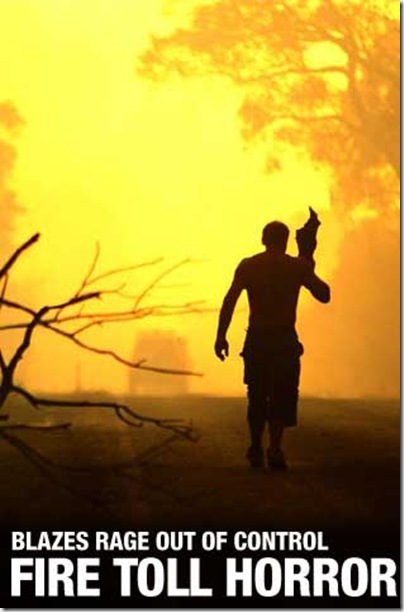 As indicated by this banner from the Brisbane Courier Mail, this creates great heat.
As indicated by this banner from the Brisbane Courier Mail, this creates great heat.
Once the fire gets into the tree-tops, the heat created quickly ignites adjoining trees. As they ignite, the growing heat creates its own wind, leading to firestorms.
Now driven by growing wind, the fire leaps from tree-top to tree-top at increasing speed, changing direction as the wind changes. Gusty variable winds can make firefighting an absolute nightmare.
Driven by fire created winds, embers can be carried long distances, creating new spot fires. The fire front grows, speed increases. The current Victorian fires spread so fast that there was no effective time to respond. One minute there is just smoke in the distance, the next minute the fire tops the nearby hill, a minute later the trees are burning around you.
As shown to great effect in this photo from The Age, the fires create huge plumes of smoke. This plus the heat can create local thunderstorm conditions. The resulting lightning can create new fires.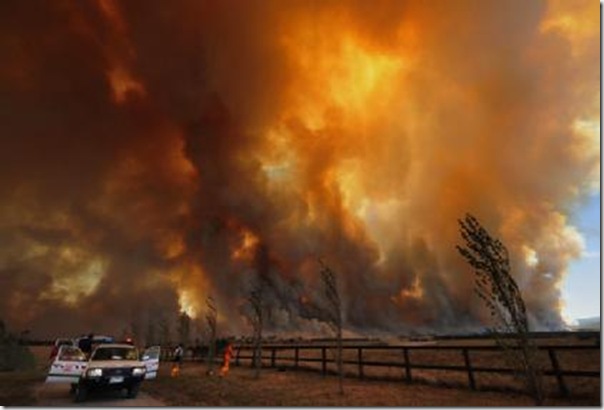
Australia depends on volunteer fire fighters for its front-line bush fire fighting. Each year some die, more have lucky escapes. They continue because of the camaraderie involved.
Australia faces a problem here. We are losing people from many country areas, while those who remain are getting older. Our fire fighters, too, are getting older. There may come a time when there are no longer the people there to provide the volunteer service.
But for the present at least, the volunteer service continues.
Postscript
Even as I was writing this story, more news was coming through. This is captured in the new Courier Mail banner.
I don't know about you, but to be burnt to death is about the worst death I can imagine. 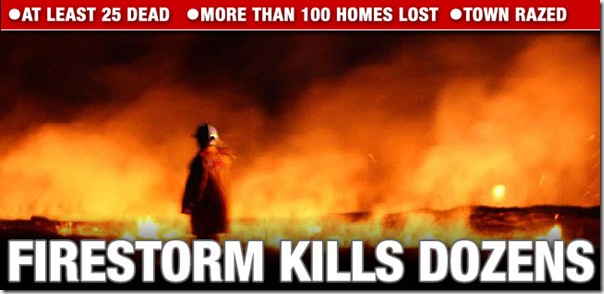
Postscript 2
The number of dead is 26 and rising. Many of those who died appear to have died in their cars, probably trying to escape.
Australian bush fire advice is quite clear. If you are prepared and confident, stay with your home since this will give you the best chance of saving it.
If you want to go, go early.
If you cannot do this, stay with you home. A car is no protection. A house provides protection against the fierce heat of the fire front. By the time the house catches, the worst heat should have passed.
Saturday, February 07, 2009
Family stories - Drummonds and Belshaws
Cousin James has just posted more than 200 family photos from Aunt Kay's (his mother's) collection.
He has done it very well. Each photo is tagged. You can check the photos by decade from the 1890s to the 1980s, by name, by house, by topic. They are the story of a family. If I and the other members of the family do likewise, we will have a remarkable record.
All family stories are interesting if told properly. Ours is no different.
It is the story of a British Empire family, as are so many Australian family stories. It is a story that spans countries and time. It is a story that links modern Sydney with a remote past.
The following photo was taken in Glen Innes in the 1920s. My grandfather moved there from inverell following his election to the NSW Parliament. The little girl with the black skirt in front of the women in the hat is my mother. To the right beside her are Aunt Kay and Helen. Eldest, Helen, was a dead spitting image of my mother at the same age. 
Time passes. It is now the 1950s. Aunt Helen goes to Malaya as a nurse with the British Red Cross.
The emergency is raging. Her role is to travel around the kampongs bringing medical support. As a Red Cross worker she travels without military escort. The Red Cross must be neutral. Helen falls in love with Malaya and returns many times. The following photo is probably taken around 1959.
Sydney was booming when great grandfather Morris Drummond arrived from Scotland on the John Elder on 19 March 1879.
Work was easy to come by for a master stone mason. He sent for his fiancee, Catherine McMillan. They were married on 21 April 1882. The following photo shows them around the time of their marriage. 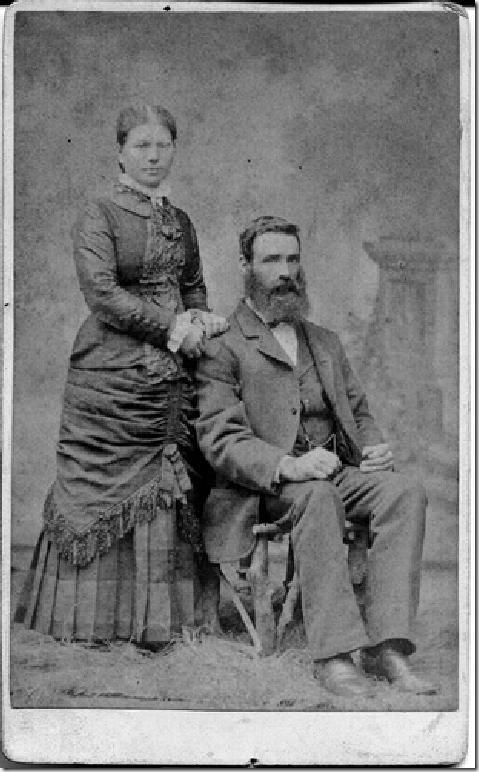
My grandfather David Drummond was their third surviving child. By the time he was born on 11 February 1890 the Sydney building boom had crashed into depression. Morris found work hard to come by. Then in May 1892 Catherine aged just 37 died in child birth.
Morris remarried in 1985, only to die the following year.
David Drummond seems to have been something of a difficult child and did not get on his with his step mother. His difficulties were compounded by complications from an operation for tonsils in late 1901 or early 1902 left him almost completely deaf. It would be more than twenty years before a hearing aid gave him something approaching his hearing back.
In 1902 David Drummond became a ward of the state. While his family kept in touch, the experience marked him deeply.
On a cold day in 1907, the seventeen year old David Drummond arrived in Armidale to take over management of a small farm. The following photo shows the boy around his seventeenth birthday, 11 February 1907. 
Drummond's arrival in Armidale marks the turning point of his life, the start of events that were to lead him to public prominence. Central to this was his love for the North of NSW, a love that I share.
In 1912 David Drummond married Pearl Goode, John and Ellen Goode's twenty five year old daughter Pearl.
John Goode has originally come to Arding near Uralla to search for gold on the nearby Rocky River gold fields, but had then pre-selected land and become a successful small farmer. The Goodes remain in the district. Cousin Arnold Goode has become Uralla's most prominent local historian.
In 1938 the New England University College opened its doors, one outcome of Drummond's work. My father, James Belshaw, was the first staff member to arrive for duty. There he met Edna Drummond, David Drummond's eldest daughter and the College's first librarian. The photo below shows mum and dad on their wedding day, 8 January 1944. 
The Belshaws were a Lancashire working class family. Both grandfather and grandmother Belshaw left school at twelve, one to go into the pits, the other into the mills.
Grandparent Belshaws emigrated to New Zealand in 1908. There, unable to become a minister because of his limited education, grandfather Belshaw became a home missionary in the Primitive Methodist church. This religious link is strong on both sides of my family.
I am not sure where the Belshaw drive for education comes from, although it is typical of many English working class families of the time. However, of my grandparents' three children, one (May) became a teacher, two (Dad and Horace Belshaw) became senior academics in economics.
In the next generation, both of Horace Belshaw's children (Cyril and Michael) became senior academics with a focus on anthropology.
If my new state and New England populist views come from grandfather Drummond, my love of economics, history and anthropology comes from the Belshaw side. In writing as I do about Australia's Aborigines, I am conscious that I am carrying on a family tradition, if in a somewhat different way. It seems that we cannot escape our pasts!
One of grandfather Drummond's dreams was to own his own place. Finally he achieved this, buying Forglen around 1938, only to sell it in 1951 because he could not manage the property and his role as member of parliament.
While I was very young when the property was sold, I remember it very clearly. Go faster, go faster we would say on the way there. Go slower, go slower on the way home.
The following photo shows Gran on a horse. This is a younger Gran than I remember her. I was probably born around the time this photo was taken. Hard to believe that I could ride when I was five, only to forget it later.
The next photo shows me on the verandah at Forglen.
I remember this verandah very clearly. The fruit trees were to the immediate left. Further down to the left was the wool shed. In the front was the home paddock. Memories! 
Friday, February 06, 2009
Reserve Bank of Australia's economic assessment February 09
I am pleased to report that the RBA's latest assessment of the economic outlook seems remarkably close to that I have been putting forward for some time now.
Do read it. I think that you will find it reassuring.
The RBA material also answered a conundrum that had been concerning me and on which I wrote in Are all the Australian economic forecasts wrong?. I will update this post tonight, in so doing also answering a request for clarification posed by Secret Admirer.
One of the reasons I am so cautious when writing on technical or professional matters is the fear that I might be wrong.
You have to remember that while I have considerable knowledge in some areas, it is not necessarily up to date. I find that the best approach is to start with very basic questions. That way I can test while learning.
Many people are frightened to ask basic questions. They accept the authority of the expert. Yet experts can be wrong. So you should never be frightened to ask people to explain until you do understand.
In my own case, my curiosity and desire to test can create problems in a working environment where people just want to get on with the doing.
We all know the chronic questioner, the person who tries to stand on principles no matter how inappropriate in the case in question. Yet in perhaps 10% of cases I have been right, forcing subsequent changes.
This is really getting into another discussion, so I will finish here.
Heat Wave!
Southern Australia has been experiencing a rolling heatwave. In Melbourne, high temperatures brought the city's rail system to a grinding halt as rails buckled and trains were delayed or cancelled. The heat wave has now moved north to Sydney.
Coming out of the office yesterday, I hit a wall of heat. Temperatures where we live are tempered by sea breezes. These disappear as you move west in Sydney.
Temperatures at Paramatta where I work can be several degrees higher than those at home. Move further west to Penrith and temperatures go up another degree or so.
I grew up in a fahrenheit world. I also grew up in a cooler world, not because of global warming but as a consequence of altitude. I mention all this because with celsius temperatures I find that I don't know how hot it really is. I know it's hot, but how hot?
This is another small example of something that I have mentioned before, the way in which the language and the underlying constructs affect perceptions.
In my earlier world, 1oo degrees fahrenheit was the dividing line. Eighties and nineties were hot. Pass 100 and you have entered very hot, heat wave territory. Dogs and humans stayed in the shade.
In both Melbourne and Adelaide there were a number of days over over 40 degrees celsius, sometimes well over 40 degrees. This weekend temperatures in some parts of Sydney are forecast to reach 44 degrees. Now I know that's hot, but how hot is it? My fahrenheit mind still thinks of 40 as cold!
In this case I looked at the temperature conversion chart.
One hundred degrees fahrenheit lies between 37 and 38 degrees celsius. Okay, so that's my definition of heat wave. Forty four degrees celsius is just over 111 degrees on the old scale. Now my mind understands. That's bloody hot!
Just at present, I am working in an area where a large proportion of the staff come from regional NSW. From my viewpoint, that's very pleasant. There is also an unusually high proportion of smokers.
Yesterday chatting outside during a smoke break, a colleague told me that he had been talking to friends in Brewarrina in the far north west.
They had come into town to do some shopping. The reflected road temperature was 51 degrees celsius, 124 degrees fahrenheit. It was so hot that the car tires were sinking into the soft tar, leaving tyre marks in the bitumen. I fear that's too hot for me!
In my train reading, I have now finished Jim Fletcher's Clean, Clad and Courteous, a history of Aboriginal education in NSW.
The book was published in 1989, so really finishes at the start of the eighties. For that reason it captures attitudes at that point in time.
As with Byzantium, you can expect to be burdened with thoughts generated by the book. But not now. I need to water some seedlings.
Thursday, February 05, 2009
Forecasting Problems
While I often disagree with conventional lines, it is quite rare to find myself in a position where my own views diverge from most popular sides in a current debate. Yet this is where I stand now on the economic outlook.
In my last post on this blog, Confusions over current economic forecasts, I recorded my confusion over the growing gap between my own views on the Australian economy and the various comments and forecasts.
I have just put up a post, Are all the Australian economic forecasts wrong?, in which I examined one issue.
In some ways I hope that people can point to mistakes that I might have made. Otherwise, we have a bit of a mess.
I will provide an economic analysis of Mr Turnbull's position tomorrow.
Just at present, I think that the best thing that I can do is provide further analysis pointing to issues.
Confusions over current economic forecasts
The economics of the Rudd Government's $A42 billion stimulus package sets out my initial analysis of the latest economic measures. I have left the small tax measures out for later analysis.
I am completely confused by the variance between some of the language and forecasts around and my own perceptions of what is happening and is likely to happen. Could I be so wrong?
To illustrate my point, take the trade side. The Government's economic forecasts suggest a deficit on the current account in 08-09 of 4 1/2% of GDP, actually a considerable improvement on the year before.
To the end of December Australian Bureau of Statistics data shows a surplus - the first for a while - in the half year to December 08 of something over $4 billion on the balance of goods and services. I haven't attempted to do the maths, but given this, these forecasts would appear to require a massive short term deterioration in Australia's trade position.
There are clear vulnerabilities on the trade side. Here the one that I am watching most closely is one rarely mentioned, our export of education services. This is, I think, our fourth largest export earner and must be counted as very exposed.
All this said, I am struggling to see how we get to a current account deficit of the projected size. If we do get to a deficit of this size, then the projection for the following year - an improved deficit at 3 3/4% of GDP - would seem suspect.
Part of my problem may lie simply in my economic rustiness. The current account includes the balance on goods and services plus the net return on investments abroad. Quite clearly, Australia's return on its overseas investments will be down, while interest and dividend payments from Australia may increase.
Is this sufficient explanation? I simply don't know.
All the discussion in the Government's latest forecast focuses on the trade side. Still, we will know quite soon who is right. Preliminary January trade figures will be released later this month. They will have to show a major deterioration if the forecasts are to be "achieved".
We have a particular problem in all this in that local commentary is being driven by short term global developments, whereas the Australian economy remains a little out of step despite the best endeavours of people to talk it down.
On the global front, there are now some scattered signs of stabilisation and indeed improvement. These may still be swept away, but I still see no reason to vary what I said last November:
Major developed countries are going to have a nasty downturn whether we like it or not. This is already flowing onto other countries including China where unemployment appears to have risen sharply as a consequence of the downturn in manufactured exports.
In some ways the global financial system is awash with liquidity. However, and putting the financial crisis itself aside for the present, this will not translate into extra activity because people (consumers and business) are reluctant to borrow unless really forced to and then banks are reluctant to lend.
Most governments are putting old fashioned pump priming measures in place intended to stimulate consumption and investment. These will take time to come into effect. Further, the initial effects will be muted because some of the initial spend is likely to flow into savings and debt reduction. People just don't want to spend when things are so uncertain.
To my mind, the big kicker will come as increased government investment spending kicks in. This will vary from country to country, but in all cases will take time. With exceptions such as China which already has projects in the pipeline, governments will have to create project pipelines. From experience, it is likely to be eighteen months before spend accelerates in most countries.
Note that I have said nothing about confidence effects. My personal view is that there may well be more shocks and that, in any event, pessimism is likely to remain dominant until things have clearly started to improve.
Pulling all this together, my best guess is that we are going to see a deepening recession in most major industrial countries over the next twelve months. I do not see how this can be avoided, although the effects are going to vary from country to country.
Beyond this point, I would expect to see progressive strengthening in global economic activity as further investment spend kicks in. This is based just on mechanical economics 101 style analysis.
I really can't see in all this just how a depression might occur in global terms, barring some total catastrophic collapse. My bigger worry is the likelihood that the combined total of Government responses will over-shoot, creating a new set of problems on the other side.
The global downturn has been a little worse than I expected, but not much. It was always going to be bad.
None of this means, by the way, that I support Mr Turnbull's position. I do not. But that's a subject for another post!
Wednesday, February 04, 2009
The intellectual fascinations flowing from the global economic crisis
For someone like me - I accept that I am strange - the current global economic crisis is full of fascinations.
Some of the ideologues of the right argue that the crisis is due in large part to low savings and loose monetary policy in certain countries. They are probably correct.
They then argue against budget deficits and borrowings. The sooner we take our medicine, the better things will be. Here I think that they are at at best partially right.
The ideologues of the left argue a very different line.
They suggest that a key element in the crisis lay in over-obsession with the role of the market and the consequent failure to regulate properly. I think that this is partially true, although those on the right argue that that the problem would not have occurred with the right monetary policy settings.
They welcome the return of what they see as Keynesian economics and of a more active role for Government. They suggest that a key response to the crisis should be greater Government regulation, even nationalisation of the banks.
I find myself partially in sympathy with the left.
I, too, have objected to the mindless obsession for budget surpluses and against any form of Government borrowing. I, too, have complained about the run-down in the country's physical and social infrastructure.
Beyond this point, some of the arguments that I have seen from the left have very little to do with economics, everything to do with past battles.
The world changes, and as it does our approach needs to change.
In an interview, Mr Rudd attacked Opposition leader Turnbull for citing a US economist called John Taylor, sneeringly suggesting that Professor Taylor was influenced by the US economist Milton Friedman. I thought that Professor Taylor must be some fringe academic, so had to look him up. He appears to be a very distinguished economist indeed.
Mr Rudd's attack said little about the validity of Mr Turbull's arguments, much about Mr Rudd.
Keynesian economics went out of fashion because it had no answers to the problems of the 1970s, a world dominated by stagflation (high inflation combined with low economic growth). Professor Friedman's arguments became influential because he seemed to be offering insights in a way that Keynesian economics was failing to do.
Today, stagflation is not an issue, although it could become one in the future. This removes one of the major impediments to the application of Keynesian economics. However, this of itself does not destroy the value of the insights offered by Professor Friedman.
In responding in the way he did, Mr Rudd offered nothing to the discussion. It was just a political shot.
By the way, just so my own views on Mr Turnbull's approach to economic policy are clear, I disagree with him.
Beyond the politics, there are some fascinating market and economic dynamics playing out.
Prior to the emergence of the bill and inter-company money market in Australia, the banks were the source of business loan finance. This made equity issues very important.
Shareholders looked to those issues as a way of increasing stakes and of realising money from rights' sales. As share prices rose, companies made bonus issues in part to keep the price of their shares down because this aided capital raising from shareholders. Shareholders liked this because they had more shares. They could then sell some if they need to raise capital while retaining a shareholding.
While international capital markets have begun to stabilise, they are still fragile. Further, the nature of various Government bail-out packages means that banks are lending to their domestic companies first. Consequently, international banks are withdrawing from the Australian market.
This puts the Australian banks with their control over large deposit bases in a very good position. Ignoring bad debt issues, the spread between borrowing and lending interest has widened. The banks have also tightened up on their lending criteria - credit rationing is in force. In some senses, we have gone back to the 1950s.
With domestic credit tight and international borrowings difficult, Australian companies have turned back to share issues in way not seen for many years. Over $A8 billion has been raised through new share issues since 1 January.
The scale of share issues has really soaked up funds available for equity issues. Australia's compulsory superannuation deduction stream means that a constant stream of new investment money does become available. Even so, firms are likely to turn back to ordinary shareholders in as a source of funds. I, for one, will welcome this.
I have suggested before that this downturn will accelerate the shifts in the global economic tectonic plates that were already underway. We can see this happening.
Forget China's problems. The country has cash. There are already signs of this flowing to investment in Australian resource firms to take advantage of the current downturn. So we are going to end up with closer linkages with China.
One thing that also interests me is what all this might mean for Australia.
I have argued before that Australia faces an inevitable decline in its relative economic ranking. If, as I expect, the country comes through this crisis with an intact banking system, financial markets and industrial structures, then we are going to be in a remarkably good position to take advantage of the next upturn.
Tuesday, February 03, 2009
Rudd $42A billion stimulus package - a few parameter facts
Tonight and early tomorrow morning I plan to write a full post on Management Perspectives on the Rudd Government's new economic stimulus package, dropping below the headline's to look at the underlying economics. I will put a cross-link here when the post is finished.
I was quite annoyed at the doom and gloom language Mr Rudd used in launching the package. I thought that this was quite the wrong approach.
In this post I want to focus briefly on just two parameter facts linked to the package, one an opportunity, the second a constraint.
The numbers in the package sound big and they are. But they need to be put in perspective.
Australia is an $US821 billion economy. The Howard Government exited with a budget surplus and no National Government Government debt. This gives us a fair bit of scope to move.
I would see no problems with Federal Government debt of perhaps 20% of GDP ($US210 billion). We could easily service this, retiring it as conditions improve. This means that there is plenty of scope for major new stimulus packages of the right type.
That's the opportunity. The balance of payments is the constraint.
As I have said many times before, our balance of trade on goods and services moved into surplus at just the right time, providing a further buffer. Because we import so much, economic stimulus flows over into imports at a time when exports are declining.
There would be nothing wrong with a trade deficit at this point. It spreads the stimulus. However, the size of any deficit is an issue because it has to met by either overseas borrowings or exchange rate movement. There are limits to both.
Postscript
I listened to Mr Rudd interviewed on TV tonight.
In response to a question as to whether the states could deliver their side of his stimulus packages in the required time horizon, the headmaster delivered a lecture that boiled down to this. They had better, or they will be financially penalised.
I almost yelled at the TV. Long before the financial crisis, I started warning that our current administrative systems are locked into patterns that make them less efficient and responsive. This applies to states, Commonwealth and the relations between them.
Since October I have cautioned that those systems - again I include the Commonwealth - are simply not geared to deliver in the required time horizons. I add my own estimates of response time delays in making economic assessments.
The delivery lags are not uniform.
Centrelink could make the required payments in early December from the first big stimulus package because this was a processing issue. I am not saying that it was easy, but it could be done.
Reading local newspapers I see that local councils have been able to get things going because they have quite big wish lists and are not bound in complicated administrative arrangements.
This is not true when we come to the bigger public service organisations. Life really gets complicated here.
I won't say any more until I have looked at the detail of the latest package.
Saturday Morning Musings continued - the unforeseen effects of Women's Liberation - 3 and final
At the end of my last post in this small series, Saturday Morning Musings continued - the unforeseen effects of Women's Liberation - 2, I suggested that
Issues of love and companionship are just as important to today's young as they were to past generations. The courtship dance continues, but in different and more complicated ways that I must admit that I do not fully understand.
Part of the complexity lies in the fact that I mentioned, that I now live in a women's world and so have limited contact with young men. I do not necessarily know what they think about these issues. Part, too, lies in the complicated patterns of today's tribal young.
Beyond all this lies the fact that relationships today must be individually negotiated. At one level, this has always been the case. However, the need to accommodate dual careers has made the process more complicated.
I first became aware of the sometimes unseen impact of two income families almost thirty years ago.
Australia was going through one of its periodic mining booms leading, as is normally the case, to skills shortages. I was preparing advice for my minister on the problem. In doing so, I was struck by the decline in Australian labour mobility over just two decades. Movement to a new location now involved judgments about two incomes.
By then, the social changes associated with movement of women into the work place and into careers were well underway. However, we were still dealing with first round effects. The key feminist focus remained equality of opportunity for women.
The position today is very different.
The emergence of mass university education in Australia during the 1970s led to a rapid increase in the number of university educated women. This process has continued to the point where women make up more than half the enrolments, sometimes well over half, in many courses.
The average age of marriage rose, while an increasing number of women chose to defer children, thus allowing them to focus on careers. Now many are having their first children.
These changes are reflected in the focus of discussion. Issues such as glass ceilings are still discussed, but now the dominant focus lies in the management of life, relations, children and career.
From 2000, the concept of work-life balance emerged as a major issue. This was due partially to increasing working hours and work pressures. However, it also reflected the increasing pressures upon women. Having won the war, women were now dealing with the consequences.
I watched this change from my perspective as a management consultant. From 2000, many of us were writing and talking about the implications of the rise of work-life balance. By 2004, the first effects were clearly flowing through in the professions.
Around 2000 one of my wife's friends resigned as a senior manager in a top accounting firm because of what she saw as a continuing male dominance. This is the old glass ceiling effect. Eight years later firms like this were worrying about retention of their female workforce, about the social changes that had taken place among men as well as women that meant that fewer people aspired to partnerships.
Like all social changes, this new one has been moving in fits and starts. You can see this in our own immediate blogging world from the sometime posts of Legal Eagle on the issue.
The current global economic down turn will certainly affect the new trend. Increasing work flexibility and staff retention are not major priorities at a time when firms are cutting staff, when people are worried about just retaining jobs. Despite this, the trend will continue because it is based on, and is a response too, new social structures.
Earlier, I spoke about the impact of two income and, later, two profession families in reducing labour mobility.
Australia's Bureau of Statistics still suggests that the Australian population is a mobile one. The reality is a little different. Yes, the population does move, but it does so in quite circumscribed ways. Real labour mobility has dropped over the last fifty years.
Regional Australia has been badly hurt as a consequence because it has been hit by two interacting trends.
The first is the one I have mentioned, the need for two incomes, two careers. This is easier to achieve in big centres. The second has been the ever increasing length of training that has added up to ten years to some programs in medicine. In combination, they have drained people from some regional areas, prevented people from moving to those areas.
Take, as a simple example, the case of someone who goes to one of the metropolitan cities for their medical training.
Increasingly, they do another degree first. Then they have to do their specialist training. They may be 32 or 33 by the time they finish. By then they have partners and sometimes children. Movement back to regional Australia is now a very major move, one that few make.
In Australia we tend at policy level to deal with symptoms, not underlying causes. In the case of doctors, it took a very long while to recognise that the only solution to the problem was actually to train people outside the metro centres.
A Charles Sturt University Vice Chancellor put this issue simply and bluntly. If someone studies at Charles Sturt and marries someone they meet while studying, they are likely to stay in the country. If they go to Sydney, they are lost for good.
I will finish this series here with a final comment on the young.
As a father, I want my daughters to achieve their potential. As I watch the swirl of people and relationships across their respective sets of friends, I do wonder sometimes just how they will negotiate their way through the minefield around them.
To my mind, we have removed one paradigm, but have yet to properly define its successor. However, that's a matter for another post.
Monday, February 02, 2009
Monday Meanderings
Just a few meanderings.
At last Niar has told us something of her new life in Jakarta. I have been waiting to hear something.
I hope to continue my Saturday Morning Musings series on women's liberation tomorrow.
I am obviously writing from an Australian perspective. Here Ramana came in with a very interesting comment on Saturday Morning Musings - the unforeseen effects of Women's Liberation - 1 looking at things from an Indian perspective.
I will leave you to read the comment, but I was struck by his distinction between Western and Modern. I have to think about this, because I think that it is an important insight. I can define Western, but how do we define modern?
Those who read this blog on a regular basis will understand why Lynne's story LIVING IN THE NORTH struck such a cord. I will comment properly in several posts.
The article I wrote for Business Solutions Magazine, Understanding the Current Economic Crisis, has finally appeared. Very glossy!
I cannot give you an on-line link, there isn't one.
When I heard that it was about to be published i was very nervous. After all, I wrote it more than six weeks ago, and who can say that things have not changed since?
There are a few lines I would alter. But the core message - the need to manage downturn while planning for renewed growth - and the supporting analysis holds up.
Well, I'm tired. I am back to getting up at four to do things. This morning I needed to be at work early, so left before seven. No breakfast, and then things were so busy I did not get any lunch. Silly, I know, because by the time I had cooked tonight I really did not want to eat.
Tired and I cannot concentrate.
Sunday, February 01, 2009
Blog Performance - January 2009
Total visitor numbers on my various blogs to end January follow. I knew visitor numbers were down, but not the extent. It is a long while since visitor numbers on this blog were that low.
Part of my problem is the that the weekly Express column has added the equivalent of another blog. The added travel time associated with working in Parramatta has also reduced blogging time. When I get behind in posts, numbers drop.
That does not explain the fall in numbers on this blog. Here I have kept posts up. Regular visits are down a little, search engine visits down a lot. I guess that I have been picking less popular topics.
Over February I plan to try a couple of experiments. I will report on these later.
On a related matter, January revenue from Google Adsense was the lowest since I put ads on the blogs. I guess the global recession is biting a bit.
| Blog | End December | End January | January Visitors |
| Personal Reflections | 45,997 | 47,659 | 1,622 |
| Managing the Professional Services Firm | 19,739 | 20,259 | 520 |
| New England, Australia | 18,936 | 19,550 | 614 |
| Regional Living Australia | 11,676 | 11,970 | 294 |
| Management Perspectives | 7,867 | 8,268 | 401 |
| New England's History | 3,199 | 3,488 | 289 |
| History of Australian and New Zealand Thought (joint) | 1,436 | 1,501 | 65 |
| Belshaw sans words | 477 | 492 | 15 |
| Total | 109,327 | 113,187 | 3,860 |
Total visitor numbers follow. This puts the overall January fall in context. The only positive is that January levels were a bit above January 2008.
| Month | Visitor Numbers |
| January | 3,860 |
| December | 5,011 |
| November | 5,469 |
| October | 5,552 |
| September | 4,857 |
| August | 3,991 |
| July (average June/July) | 3,962 |
| June (average June/July) | 3,962 |
| May | 4,296 |
| April | 4,536 |
| March | 4,294 |
| February | 3,710 |
| January | 3,656 |
| December 2007 | 2,844 |
| November | 3,612 |
Finally, the following table will show total page views. I will add January later.
| Month | Page Views |
| January | |
| December | 11,656 |
| November | 13,842 |
| October | 14,112 |
| September | 12,160 |
| August | 9,859 |
| July | 9,292 |
| June | 10,635 |
| May | 10,846 |
| April | 11,058 |
| March | 10,969 |
| February | 9,456 |
| January | 9,485 |
| December | 7,447 |
| November | 9,239 |
Saturday Morning Musings continued - the unforeseen effects of Women's Liberation - 2
I finished my last post, Saturday Morning Musings - the unforeseen effects of Women's Liberation - 1, by suggesting that I found the views of today's young quite conservative.
I have to be careful here. In one sense, there is no such thing as "today's young". My daughters' generation is just as varied in mix and across space as older generations, perhaps more so. I cannot pretend to understand all the variety. So my comment should be read as an impression.
Conservative does not mean, however, that they hold the same views on gender issues as past generations. Their views are more complicated, more nuanced.
To my mind, the single most important outcome from the feminist revolution, was the acceptance, indeed the expectation, that women would have careers. I say careers, not just the right to work.
In this context, we need to make an important distinction between acceptance of the right to a career as compared to the idea of a career as a norm. The first was well established by the sixties, the second took much longer.
The evolutionary process was not without its problems.
Men did not suddenly give up their own view of the world. Existing relationships based on the traditional view of marriage came under strain. To quote from an email I received after my last post:
No when women had to work within the couple, and started earning more money, becoming better educated than their spouses during the turn of this social event. It caused disenchantment. Certainly did with me and my ex spouse.
He resented me working. And I resented him expecting me to bake him a roast dinner and entertain his mates, after I had done 12 hours work (including travelling).
Pat's comment illustrates a second dimension beyond marriage strain, the continuance of traditional female roles. There is plenty of statistical evidence to suggest that the mass entry of women to the workforce meant that women had to work harder because they had added paid work to continuing home duties. Men did not increase their home duties to the extent required to compensate.
In time, this led to a counter revolution combining two very different streams.
The first stream represented a conservative reaction, a re-assertion of perceived traditional values, of the importance of family, of child care. The second stream involved women's responses. Faced with the load of work and home duties, women began to question whether women's liberation was really liberation at all.
All this played out not just in official debate but, more importantly, across the pages of the popular press and in women's magazines. Women agonized over the pressures and the choices they had to make. In time, this established a new principle, the right of women not to work, to be full time mothers if that was what they chose.
To a degree, men dropped between the cracks in all this.
Improved educational opportunities for women was a key issue in the feminist revolution. Boys dominated the education system, girls had to catch up. The outcome was a series of educational initiatives intended to give girls better educational opportunities.
These were almost too successful. By the late 1990s there was an apparent and growing reverse gap between girls and boys at school level. This flowed over into university attendances. The focus began to shift to ways of improving boys' education.
This was not the only sign that things were not right with Australian men.
There were increasing rates of male depression and of suicide, especially among young men. Books began to appear on bringing up boys. There was talk of the need for a men's revolution. New initiatives appeared such as MensShed intended to link together socially isolated males.
One central difficulty in all this was that men no longer had a defined role. This was reinforced by continuing economic shifts that reduced demand for occupations requiring physical labour, a traditional male strength. Some commentators queried whether the male half of the human species in fact had a future.
Those men who did move to take greater roles in activities such as child care faced unseen but difficult gender based discrimination. This is best illustrated by my own experience.
At the end of 1995, my wife accepted a position in Sydney as CEO of a firm of patent attorneys. After moving to Sydney, I chose to work mainly from home and to take on the primary child-care role. There were quite a number of other fathers at my daughters' school who had made the same choices. Swapping notes, we found that we all shared similar experiences.
Australia's current obsession with paedophilia has created a profound distrust of men. This worsened over the time that my daughters were at school.
A man in a girl's environment is always under scrutiny. Fair enough, perhaps, but it does make life difficult in a whole series of little ways. As a simple example, other parents may be reluctant to let their girls come to play with your girls once they find out that you - a male - will be the only adult there.
Perhaps the greatest difficulty, though, is simply isolation in a world still dominated by and geared to women.
Whatever the social changes that may have taken place as a consequence of women's liberation, it remains true at least at my daughters' school that most day-to-day parent activities are dominated by women. This affects everything from topics of conversation to the selection of activities and venues for get to gethers.
Some working women I know including my own wife complain, with justice, that many activities are still geared around mothers who do not work or, perhaps, work part time or in occupations that give them a degree of working flexibility.
Yet it's far worse for a man because his very presence affects the social dynamics involved. The discrimination that follows is often subtle and unconscious.
It's partly a matter of feeling. Other men may be distrustful of a male in a wives' environment. Women may find it hard to alter their conversations, grouping with other women. But it's also a matter of the social structuring of what is still a women's world.
In the twelve years my girls were at school in Sydney, every invitation for one of the irregular daily gatherings went to my wife, hence her complaint. More importantly to me as the primary child carer, they were mum's gatherings, not parent gatherings.
The parents' gatherings were quite distinct. They were generally organised in the evening with the expectation that husbands would come.
Returning to Australia's young, earlier in this post I suggested that their views on gender issues were far more complicated and nuanced than that of past generations.
Issues of love and companionship are just as important to today's young as they were to past generations. The courtship dance continues, but in different and more complicated ways that I must admit that I do not fully understand.
I say this because I now live in a female world. I know to a degree what girls think, at least in the slice that my daughters belong to. I am less clear on boys.
I had intended to write just two posts in this series. However, there are still a number of issues that I want to tease out. So at least a third post is required.

